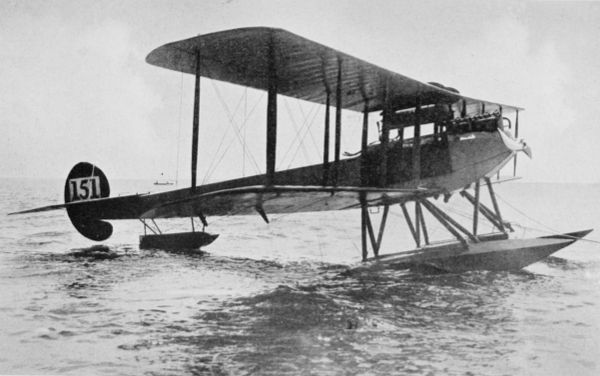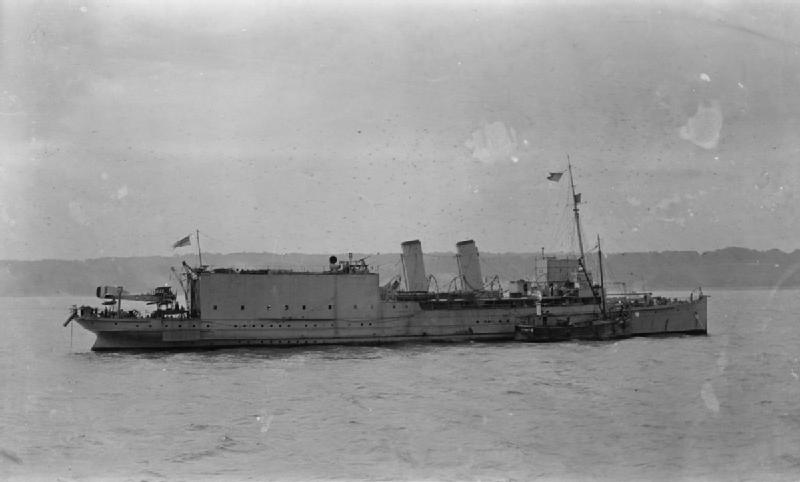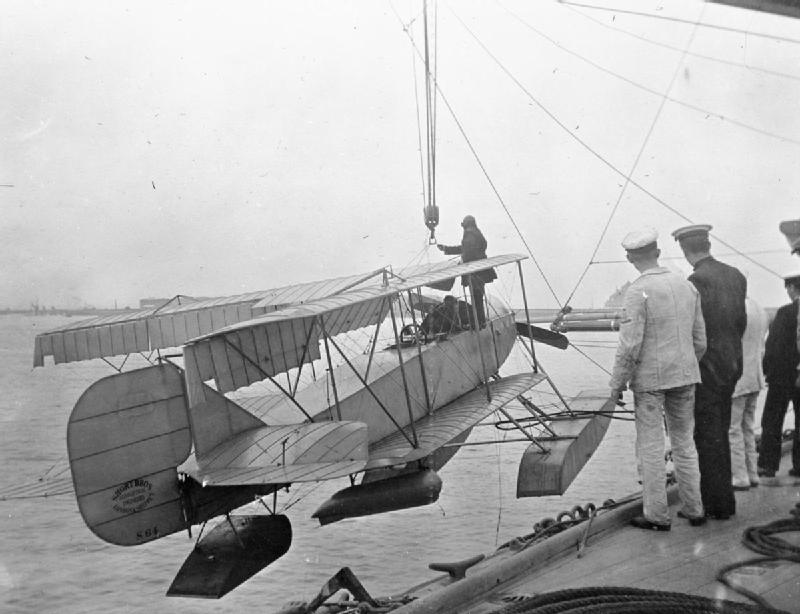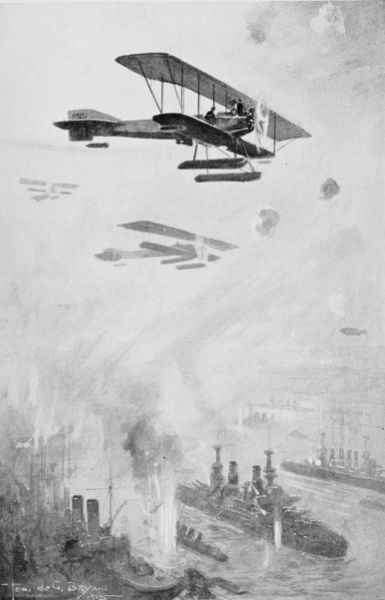The 9th Dawlish Chronicle is now available – details at end of article
Christmas Day 1914: The Cuxhaven Raid
On Christmas Day 1914 three Royal Navy seaplane carriers, Engadine, Riviera and Empress launched a total of seven floatplanes to attack the German Zeppelin base at Cuxhaven, some 25 km north of Bremerhaven. The force had been escorted to striking distance by vessels of “Harwich Force” of light cruisers and destroyers which was responsible for active – and indeed aggressive – patrolling of the Southern North Sea throughout WW1. The aircraft were all of the Short “Folder” Type though with engines of different power in the 100 – 200 hp range. As the name indicated the 67 ft span wings folded for ease of transport in the large hangars built on the after-ends of their carriers.
 One of the Short Folders used in the Christmas day raid
One of the Short Folders used in the Christmas day raid
The seaplane carriers were converted Cross-Channel passenger ferries, chosen because their top speeds (in the 20 knot range) allowed them to keep up with the Harwich force’s cruisers. The aircraft could not be launched directly from the ships, but rather were lowered by crane into the water once their wings had been extended, taking off thereafter on their floats. Recovery followed the same procedure, but in reverse, and it is obvious that for the ships at least the period of greatest vulnerability was during recovery, when it was essential to be stationary.
 HMS Engadine at anchor – note Short Folder at stern, ready for dropping for take-off
HMS Engadine at anchor – note Short Folder at stern, ready for dropping for take-off
The seven aircraft of the strike-force (engine problems held back two more) each carried a pilot and observer/navigator as well as three 20 lb. bombs. Though puny, the latter had the potential to destroy an airship filled with highly flammable hydrogen – indeed Zeppelin LZ37 was to be destroyed by Sub-Lieutenant Reginald Warneford VC with such a weapon on May 15th 1915.
 2A Short Folder with starboard wings still folded
2A Short Folder with starboard wings still folded
The Christmas Day attack was however to be bedevilled by low cloud but the Folders nevertheless found the Cuxhaven base, though the sheds in which the Zeppelins were housed were obscured by mist. The aircraft dropped their bombs, though without causing any significant direct damage. The morale effect was however marked – notice being served that German homeland targets could be taken under attack and that resources would have to be diverted from elsewhere to protect them.

Contemporary postcard showing the Royal Navy surface force. Note the famous light cruiser HMS Arethusa as flagship

A fanciful artist’s impression
Alerted by the attack, German aircraft and Zeppelins set out to find the British surface force involved. Two Friedrichshafen seaplanes, and Zeppelin L7, detected the carrier HMS Empress, which due to boiler problems was lagging astern of the formation, dropping small bombs that failed to hit. German U-Boats stationed in the area were equally unsuccessful. All British vessels returned safely to base.
The British aircraft had been airborne for over three hours and all crews were to survive. Three aircraft managed to return to their carrier and three landed in the sea off the German island of Norderney. The crews of the latter were picked up by the British Submarine E11, commanded by Lieutenant-Commander Martin Nasmith. (In the following year this commander, and submarine, were to have spectacular success operating against the Turks in the Sea of Marmara, actions which earned Nasmith a Victoria Cross). The seventh aircraft was posted as “missing” but the pilot had indeed been picked up by a Dutch trawler and he managed to return to Britain a month later.

Erskine Childers
An interesting aspect of the Cuxhaven raid was that a key figure in the planning and navigation required, and who was observer on the lead aircraft, was a 44-year old Volunteer-Reserve Lieutenant, Robert Erskine Childers, better known as the author of the classic thriller “The Riddle of the Sands”. Published in 1903, this novel centres on German efforts to stage an invasion of Britain and it drew heavily on Childers’ experience as a yachtsman off the German North-Sea Coast – the scent of the Cuxhaven Raid. An Irish nationalist, Childers had run guns into Howth, North of Dublin, earlier in 1914, for arming volunteer forces supportive of Home Rule for Ireland, using his yacht Asgard for the purpose.
When war broke out in 1914, Childers did, however, see it as ethically essential to support Britain in its death-struggle with Germany. He continued to serve in the British forces until the end of the war but thereafter devoted himself to the Republican cause in the 1919-21 Irish War of Independence. During the 1922-23 Civil War that followed the signature of the 1922 Anglo-Irish Treaty, Childers supported the Republican faction against the newly-established Free-State government. Captured, and tried on which at was essentially a trumped-up charge, he was to be executed by an Irish Free-State firing squad in November 1922. He characteristically insisted on shaking the hand of each member of the firing party. He also instructed his son, who would later be President of Ireland 1973-74, to seek out and shake hands in reconciliation with each man who had signed his death warrant. Another Irish President, Eamon de Valera, said of him, “He died the Prince he was. Of all the men I ever met, I would say he was the noblest.”
The latest – 9th – volume of the Dawlish Chronicles is now available
Britannia’s Morass
September – December 1884
 I’m pleased to announce that Britannia’s Morass was published in both Paperback and Kindle formats on 12th December 2020.
I’m pleased to announce that Britannia’s Morass was published in both Paperback and Kindle formats on 12th December 2020.
Click on https://amzn.to/39oTAWx for the US and on https://amzn.to/3ob14ki for the UK for details of how to order on Amazon.
The story involves mystery, blackmail, espionage and danger at a time when the international power balance is shifting. The secrets of cutting-edge weapons technology are highly prized – and some will stop at nothing to get them . . .
It’s 1884 and Captain Nicholas Dawlish departs for service in the Sudan, as told in Britannia’s Gamble. He leaves his formidable wife Florence behind to face months of worry about him. She’ll cope by immersing herself, as she’s done before, in welfare work for Royal Navy seamen and their families at Portsmouth.
Life in Britain promises to be humdrum, if worthy, at the start until . . .
A single well-meaning but wrong decision plunges Florence into an ever-deepening morass, where loyalty to her country and to seamen who served with her husband raises terrifying dilemmas. Old friends support her but old allies who offer help may have different agendas. In a time of shifting international alliances, in which not all the enemies she faces are British, she can be little more than a pawn. And pawns are often sacrificed . . .
Britannia’s Morass plays out against a backdrop of poverty and opulence, of courtroom drama and French luxury, of subterfuge, deceit, espionage and danger.
This volume also includes the bonus short story Britannia’s Collector, which tells of Nicholas Dawlish’s service as a young naval officer in a gunvessel operating off the coast of South America in 1866.
Below are the nine Dawlish Chronicles novels published to date, shown in chronological order. Click on the banner for more information or on the “BOOKS” tab above. All are available in Paperback or Kindle format and can read at no extra charge by Kindle Unlimited or Kindle Prime Subscribers.
Six free short-stories are available for download to your Kindle. Access them by registering for the Dawlish Chronicles mailing list – just click on the banner below. You’ll be kept updated on new books and will receive other free stories at intervals.


